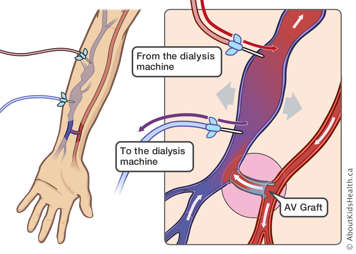What is an arteriovenous graft (AV graft)?
An AV graft is an artificial vein made from a synthetic tube inserted under the skin.

What is an arteriovenous fistula (AV fistula)?
An AV fistula is an artery and a vein sewn together.

AV access on your child's body
- Usually, AV fistulas and grafts are made in your child's forearm or upper arm. Depending on what is best for your child, the surgeon will put the AV graft in as a straight tube or as a U-shaped loop.
- Your child's non-dominant arm is used whenever possible. This leaves their dominant hand free during hemodialysis. For example, if your child is right-handed, the access will be placed in the left arm.
AV access for hemodialysis treatment
- To have hemodialysis, your child needs a vein that is easy to find and use. Once found, this vein becomes the AV access for hemodialysis.
- Before each treatment, your child's nurse will insert two needles into the fistula or graft. One needle takes the blood from your child's body to the artificial kidney (dialyzer). This purifies the blood. The second needle returns the blood to your child's body.
- At the end of each treatment, your child's nurse will remove both needles and place bandages over the needle sites. The bandages can be removed after a few hours.
Getting ready for surgery
Clinic appointment
- Your child will have an ultrasound of their upper and lower arms.
- Your child's surgeon will check your child's arms to decide whether to create an AV fistula or an AV graft. After talking to the surgeon about the type of access, you will be asked to sign a consent form to confirm that you agree to the surgery.
- Your child's nephrology team will tell you what to expect before and after surgery, including any potential complications.
Pre-admission visit
On the same day as the clinic appointment, your child will visit the pre-admission clinic. Here your child will:
- have blood tests and an electrocardiogram (ECG)
- see an anaesthetist for an anaesthetic consultation
- see an endocrinologist if they have diabetes.
Anaesthetist consultation
- During your child's visit with the anaesthetist, the doctor will talk to you about your child's health. The anaesthetist will also talk to you about which anaesthetic is best for your child: a general anaesthetic (a mix of medicines that puts your child into a deep sleep) or a local anaesthetic (freezing to the area that is being operated on) and some sedation (medicine to make your child sleepy or more comfortable during surgery).
- If you have already talked to your child's surgeon about the types of anaesthesia that may be used, be sure to tell the anaesthetist.
- Please tell the anaesthetist if your child is currently taking any blood thinning medication such as warfarin or acetylsalicylic acid (ASA). To prevent bleeding after surgery, the anaesthetist may tell you to stop giving your child this medication before the day of the surgery.
The night before your child's surgery
- Make sure your child doesn't eat or drink anything after midnight or the surgery will be postponed.
- Your child may take any medication on the morning of the surgery with a sip of water (except blood thinning medication and insulin).
What I need to know about my child's fistula or graft
Your child's AV fistula will usually take six to eight weeks to mature before it can be used for dialysis. After the staples are removed, roughly two weeks after the surgery, have your child strengthen their fistula by squeezing and releasing a rubber ball 10 times. Your child should do this three to four times a day. It is not necessary for your child to exercise their AV graft because the graft is already the correct size when it is placed in the arm. Two weeks after the surgery, or as soon as the swelling is gone, your child's AV graft can be used for dialysis.
At SickKids
Day of the surgery
Please come to the _______________________ at: ____________.
Your operation will be done at: ___________________.
The nurses will:
- help your child change into a hospital gown
- check your child's blood pressure
- take some blood to check your child's potassium count
- complete a surgical checklist.